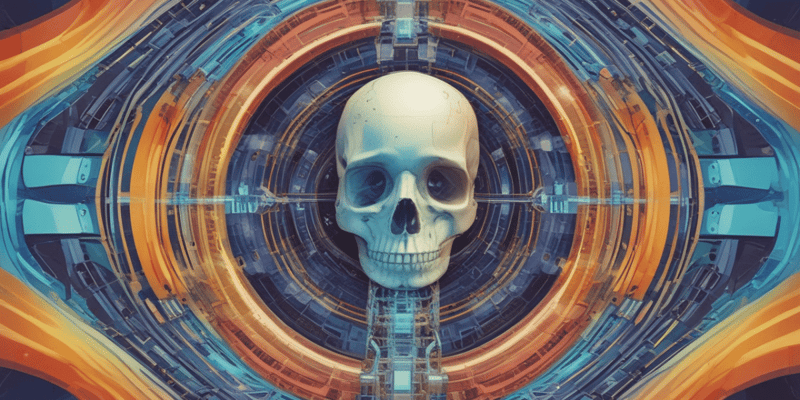Questions and Answers
Match the following imaging techniques with their advantages:
Fast imaging of large tissue volumes with wide sections = CT scanners with multiple detector arrays Covering large body sections in short scan times with thin beams = CT scanners with thin beams for high-detail slice images Increased slice thickness with reduced spatial resolution = Conventional single detector array scanners Overcoming x-ray tube output limitation = Single detector row scanning (SSCT)
Match the following statements with their corresponding imaging benefits:
Fast imaging of large tissue volumes with wide sections = Useful in studies where patient motion is a limiting factor Covering large body sections in short scan times with thin beams = Producing thin, high-detail slice images or 3-D images Increased slice thickness with reduced spatial resolution = Determining slice thickness by detector size, not collimator Overcoming x-ray tube output limitation = Preventing excess stress on the x-ray tube
Match the imaging characteristics with their respective advancements:
Fast imaging of large tissue volumes with wide sections = Introduction of CT scanners with multiple detector arrays Covering large body sections in short scan times with thin beams = Utilization of CT scanners with thin beams for high-detail slice images Increased slice thickness with reduced spatial resolution = Evolution from conventional single detector array scanners Overcoming x-ray tube output limitation = Solution provided by single detector row scanning (SSCT)
Match the improvements in imaging technology with their specific functions:
Signup and view all the answers
Match the advancements in CT scanning technology with their benefits:
Signup and view all the answers
Its speed can be used for fast imaging of large volumes of tissue with wide sections. This is particularly useful in studies where patient motion is a limiting factor. Their ability to cover large body sections in short scan times with thin beams for producing thin, high-detail slice images or 3-D images is a characteristic of ____________ technology.
Signup and view all the answers
With conventional single detector array scanners, opening up the collimator increases slice thickness, which is good for the utilization of x-rays but reduces spatial resolution in the slice thickness dimension. With the introduction of multiple detector arrays, the slice thickness is determined by the detector size and not by the ____________.
Signup and view all the answers
Overcoming x-ray tube output limitation. One problem quickly encountered with single detector row scanning (SSCT) was excess stress on the x-ray tube. That is, the x-ray tube would heat to extreme temperatures as very high energy was deposited onto the ____________.
Signup and view all the answers
CT scanning technology is known for its speed in imaging large volumes of tissue with wide sections, particularly beneficial in studies where patient motion is a limiting factor. The ability to cover large body sections in short scan times with thin beams for producing thin, high-detail slice images or 3-D images is a key feature of ____________.
Signup and view all the answers
With multiple detector arrays in CT scanning, the slice thickness is determined by the detector size and not by the collimator, overcoming the limitations of increasing slice thickness by opening up the ____________.
Signup and view all the answers
What is a key feature of CT scanning technology?
Signup and view all the answers
What does the introduction of multiple detector arrays in CT scanning determine regarding slice thickness?
Signup and view all the answers
What problem did single detector row scanning (SSCT) encounter in terms of x-ray tube heating?
Signup and view all the answers
What happens to spatial resolution in the slice thickness dimension when opening up the collimator in conventional single detector array scanners?
Signup and view all the answers
Why is CT scanning technology particularly useful in studies where patient motion is a limiting factor?
Signup and view all the answers
Study Notes
CT Scanning Technology Advantages
- Fast imaging of large volumes of tissue: CT scanning technology allows for rapid imaging of large tissue areas, making it ideal for studies where patient motion is a limiting factor.
- High-detail slice images and 3-D images: With thin beams, CT scanning technology produces high-detail slice images and 3-D images, covering large body sections in short scan times.
- Overcoming x-ray tube output limitation: The introduction of multiple detector arrays in CT scanning overcomes the limitation of excess stress on the x-ray tube, which can heat to extreme temperatures due to high energy deposition.
- Detector size determines slice thickness: With multiple detector arrays, the slice thickness is determined by the detector size, not by the collimator, allowing for thinner slices without compromising spatial resolution.
- Improved spatial resolution: In contrast, opening up the collimator in conventional single detector array scanners increases slice thickness, reducing spatial resolution in the slice thickness dimension.
- Reducing patient motion limitations: The speed of CT scanning technology makes it particularly useful in studies where patient motion is a limiting factor, as it allows for fast imaging of large volumes of tissue with minimal patient movement.
Studying That Suits You
Use AI to generate personalized quizzes and flashcards to suit your learning preferences.
Description
Learn about the advanced technology used in CT scans for fast imaging of large tissue volumes and high-detail slice images. Understand how different scanners work to produce accurate 3-D images.




